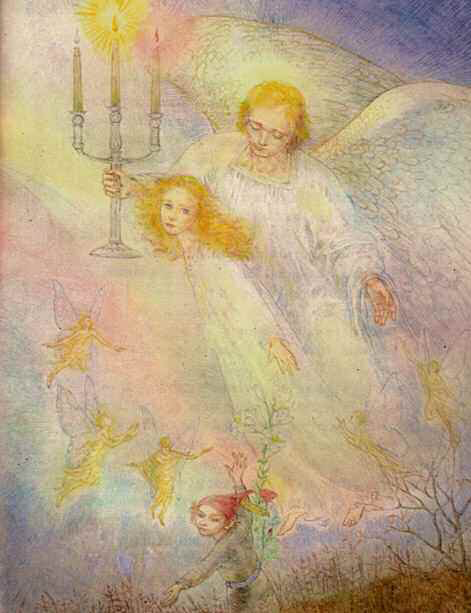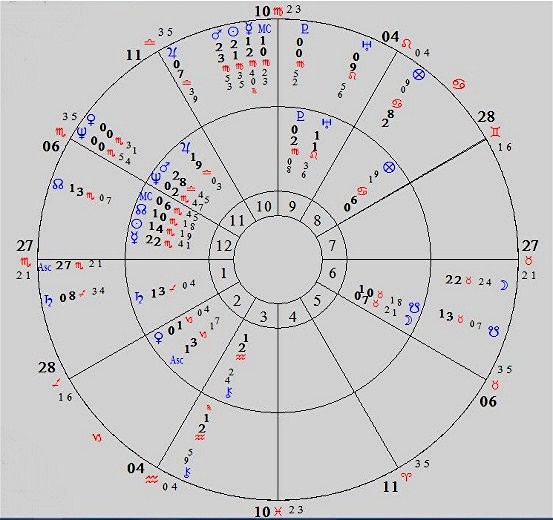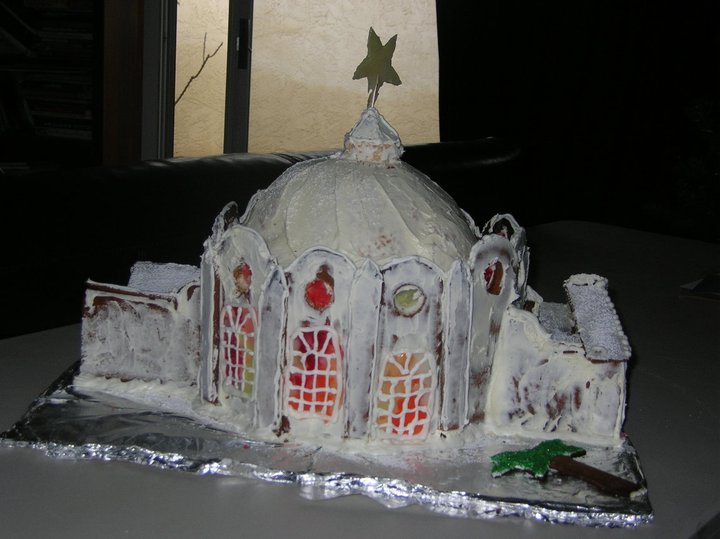The Three Candles of Little Veronica
[This book review appeared in Rays From The Rose Cross, May/June 1997, illustration by Iris Guarducci, Celestial Arts]
OCCASIONALLY A BOOK is written that at once speaks to the adult in a child and to the child in an adult. Such a book is The Three Candles of Little Veronica (Celestial Arts, Berkeley, CA, 1972). In fact, the book has a split personality, or at least is seen through the eyes of both “grownups” and young people. The young people include our younger brothers, specific members of the animal kingdom, as well as makers and shapers of the natural world, including angels. The grownups include people who have “grown out of” the childish belief in invisible beings and persons who have regained a measure of the inner light. These many perspectives on the one life are coordinated by the “omniscient” author, Manfred Kyber.
In a short introduction, the translator of the German original, Rosamond Reinhardt, sets the story’s time (“a short time before the age of motor traffic”) and place (“the lonely northern countryside along the Baltic coast of Germany”).
The book is equally concerned with the unseen in the world and the unremembered in time.
Veronica both sees her invisible present companions and remembers earlier times in other places.
As the translator remarks, “A fortunate few carry with them through life the vision of the innocent years. The rest of us must work hard to retrieve the light that is so freely given to us at birth. But if, in reverence for all life, in patient observation, in sorrow and in compassion, the veil of darkness falls from our eyes, then it is we who are the lucky ones. For in full consciousness we have reached back into Paradise before the Fall. We have earned that which every child inherits unearned.”
For many this is the stuff of fairy tales, fantasy. But the unclouded eyes of a child and the earned sight of a clairvoyant do not give us a fairy-tale picture of life: “Rather will they reveal the living truth that lies hidden in all fairy tales.”

To common sight Veronica’s garden is a common garden. But seeing with “the eyes she had brought with her from heaven,” Veronica’s was a Garden of Spirits. There she has friendly chats with beetles, caterpillars, blackbirds, hedgehogs and the spirits of Lilies. In fact, the whole garden was full of figures which “danced in the air, and if you peered into the trees you could see elves standing in them, waving.”
Kyber’s evocation of Veronica’s sunwashed seeing reminds us of the “visionary gleam” that anoints first sight as described by Wordsworth in his ode “Intimations of Immortality from Recollections of Early Childhood.” But too soon do “shades of the prison-house begin to close upon the growing boy” and “celestial light” fades into “the light of common day.” So too will the twilight come to Veronica. “It grows dark around everyone so that each may painfully become aware and thus find himself in the darkness—himself and God.”
Veronica has two special and constant companions, Mutzeputz, her visible feline confidant, wise in the ways of the world, and the invisible gnome Master Mutzchen, a rubber-faced comic and antic gymnast who is but two-hands-high. She is told that small people with lots of legs, like beetles, tend to be fussy. She discovers that dwarves quarrel a lot. Veronica is informed that she can visit a tree-bound Elf simply by stepping out of her earthly body, which is, “after all, nothing more than a dress, and inside it is a finer dress, and you yourself are in this finer dress.” She need only give herself a push, just as she does before going to sleep and then it goes by itself.
Once inside the tree in her “transparent body,” Veronica thought her earthly body made her “a bit stupid.” The Elf elaborates: “The worst of it is that the larger the earthly body gets and the more you grow into it, the stupider you become.” But once you again find the light in this darkness you become “a great deal wiser.” The Elf waxes philosophic: “To seek the light is truly the task of human beings, imposed on them by God. They must seek it out and find it, not only for themselves, but for the animals, the plants, and the stones…That is rather a difficult story though, and I cannot explain it to you exactly.” She does add, though, that “We are all asleep in the glass coffin,” like Snow White, and are awaiting deliverance, “the redemption of the world.”

The owner of the Garden, Johannes Wanderer, is Veronica’s adoptive Father. He has gained a certain measure of that light that reveals “the great ones,” but which is gained only by the opening of the eyes of the depths, which grow through tears. He has been given his son Peter to care for. Peter has difficulty understanding many earthly things and does not speak much. Though in this life he is an “imprisoned soul,” his father explains that “it is perhaps out of pity for the retarded that in this existence he has become retarded himself, so that by experiencing in his inmost being the sorrows of the backward—their seeking and their finding in all their helplessness—he may be their leader in a future life.”
Veronica is met at the top of the Elf’s tree by a sylph who conducts her to the Silver Bridge. While flying (she found it wonderfully easy and exhilarating) she is told that the deeper she goes into the garden of the Earth, the more everything is misunderstood, because of the twilight. The Bridge rose on silver columns from the Garden of Spirits and “ascended in a wide arc into the clear air and lost itself in the shimmering sunlight in a splendor unendurable to the eye.” Veronica felt as if she had often walked over the Silver Bridge. “But when could that have been—When?”
Where the Bridge lost itself in splendor stood angels with silver wings, robed in white. One of them tells her, “You came from it and you willreturn to it. But first comes the twilight. But don’t be afraid. When the darkness comes I will be waiting and I will go with you, and I will light your three candles for you, little Veronica, and will watch over you.”
Then said the Rose-souls, “Look how red our cups are. So pure and so red is the chalice of the Grail to which you will once more stretch out your arms.” Then a veil falls before the bridge and “the eyes of heaven had closed.”
Veronica’s Angel appears that night and shows her a three-branched candlestick to light her twilight, since “now your [earthly] journey is beginning.” At the end of each branch burned a small flame—a blue one and a red one at the sides, and a golden one a little higher in the middle.”
Readers will understand the color symbolism employed here, and over the course of the narrative the author adumbrates the candlestick’s esoteric significance.
As the Garden of Spirit disappears behind the veil, the House of Shadows enters Veronica’s consciousness. “Each must remember his three candles on the altar of life, or he will trip over the many steps and thresholds in the House of Shadows.” Veronica is later informed by Uncle Johannes that “each candle-flame has its own time and its own meaning. We must watch over them, so that one day the blue and red flame will merge with the golden flame burning in the middle.”
After the Morningland of Mankind, men climbed down into the dark and out of their deeds wove destinies and built Houses of Shadows, where we live today. We are to cast the light of our three candles through these Houses so that we will once more be able to live “in temples and in light-filled mansions.” But they shall have been built by our own thoughts, and in them we will experience the consciousness of a child, for “conscious childhood is blessedness.” We recall the Gospel passage, “Except ye become as little children, ye shall not enter into the kingdom of heaven” (Matt. 18:3).
Veronica has much to learn in the House of Shadows. Mutzeputz and Master Mutzchen continue to be her companions. But increasingly she turns to Uncle Johannes for guidance and understanding. She feels she has known him before. For his part, Johannes knows that Veronica has “the inner eyes which see beyond tangible things.” Of himself he says, “I have learned on my journey how to awaken those eyes again.”
The dimension of past lives is opened up and explored, for many of the characters have crossed paths before. A more advanced exchange ensues between Johannes and several women. Surnamed Wanderer, in both the sense of a pilgrim and one who is embarked on voyages of discovery, Johannes explains to one woman, called the Gray Lady, who is living in the limbo of a prior time, “We all really have this name, because we all wander from one life to another, adding to ourselves and to the building of the world. The dead and the living are only different forms of one great existence. But you have stopped on the journey. No one should do that, Helga.”
The reader meets Aaron Mendel, who seems a character out of the Old Testament. He has voluntarily assumed the role of an outcast. He too is a wanderer, but more literally so, and his wandering on the mendicant byways of life is a form of self-imposed penitence. Aaron will travel until God takes the burdenfrom Him—“When the burden has grown so light that it is no longer a sacrifice.”
There is the captivating Ulla Uhlberg, who rides horses and gazes into the distance with longing eyes. It is life she is pursuing, life towards which she rides. “But often the distance is empty and you pass life by—life is sitting, quiet and resigned, by the side of the road, bearing its heavy burdens,” Ulla is tending within herself “a fire that is red and smoldering.” It will cause a conflagration.
We meet pastor Hallor, who must learn that “the altar is not a professor’s chair for theological research.” He has to learn humility and that “there is only one road—the Road to Damascus.”

There is the town doctor, who “practices without healing…That is usual today because people don’t know about the incalculable forces anymore.”
This sensitive and poetically crafted book is jeweled with brightly faceted metaphysical insights:
• “Everything that exists is a thought…and all thoughts speak and form themselves into substance, good and bad…through every thought of goodness, a wicked person becomes better, a wild animal less savage, and a poisonous plant less dangerous.”
• “Here we are erring human beings, and we wear armor only when we hold our shield over the weak and defenseless. This has to do with the Quest of the Grail.”
• “There are so many dead who want to help you—do not pass them by. And too, there are so many dead who need your help—do not deny it to them.”
• “Light your candles! So many are waiting for it to become light again. The living and the dead are calling for it; men, animals, and all things that exist long for light and deliverance.”
• “All knowledge proceeds through pain to the light, and the one great answer that we hope to find demands to be sought with a thousand fearful questions.”
• “Animals are awakening more and more from the womb of their group and struggling more and more into consciousness.”
• “What love has created is imperishable and from it everything is formed—from the womb to the Ego.”
Through Veronica the reader sees the world with the eyes of a wise child, for she is “a very old soul.” Through Johannes we see the world with eyes that have been darkened and then washed clear by light-birthing tears. For ultimately, Three Candles is about seeing. And the author is a visionary. After having read this book, we too may know a little more, see with our soul a little more clearly, a little more deeply, and realize that though we may be set upon by adversaries and every kind of hardship, we are always in the company of a host of Beings of resplendent brightness who wait for us to call on them, that we may be blessed instruments of their power to redeem the world.
The author writes that though we “come from distant heights, and to a far-off land we make our homeward journey, yet is all distance near when it is fully comprehended.” The light emitting from The Three Candles of Little Veronica gracefully assists in that comprehension. —C. W.
Tags: Chalice, Children's Books, children's fantasy, fairytale, transparent body












